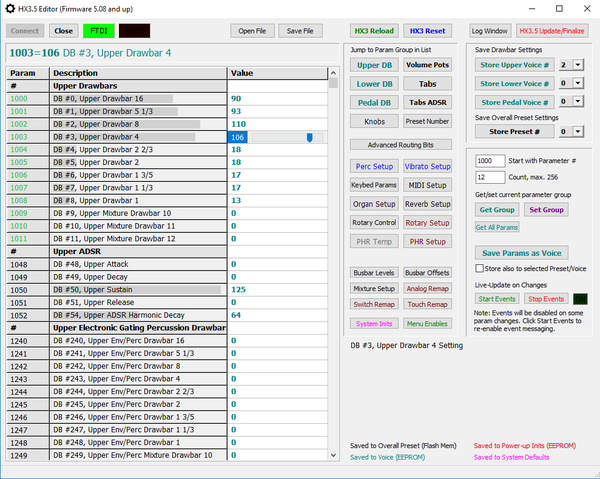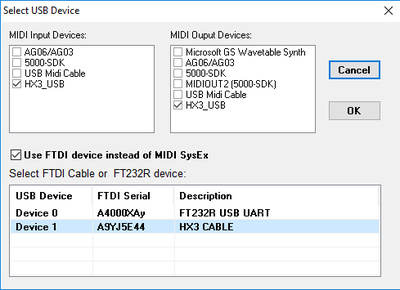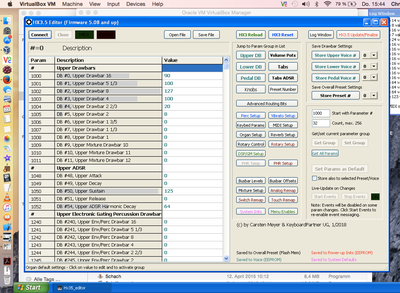HX3.5 Editor User Manual
Preface
HX3.5 Editor is a Windows application for adjusting HX3.5 parameters and setups as well as for firmware and FPGA updates. The editor for old HX3 versions HX3.4 Remote is not suitable for the HX3.5. Mac users, please see section Using HX3.5 Editor on a Mac below.
No installation is necessary. Just make sure all files contained in HX3.5 Editor ZIP file are copied to a folder on your local harddisk. All files must be present in the same folder as the HX3.5 application.
Connection
HX3.5 Editor can connect to the HX3.5 mainboard through several channels:
- through MIDI over USB using a USB connection from your PC to the B-type USB Jack of the HX3.5 mainboard or of the HX3 Extension Board mk5 (but not mk4) or to the USB-mini Jack of the HX3 MIDI Expander,
- through a bi-directional MIDI connection (IN/OUT) using a third-party USB MIDI adaptor,
- through our FTDI serial adaptor cable FT232R-5V (available from our shop). Attach USB-to-serial adaptor cable FT232R-5V to the PC USB port and HX3.5 6-pin header PL19, black wire (BK) facing to black header PL17,
- through any FTDI device with FT232 interface chip like on our discontinued HX3 Extension Board mk4. Connect the USB cable to the B-type USB jack of the HX3 Extension Board mk4 (internally, this as well goes as USB to serial connection through a FTDI interface).
Choose the channel that fits your configuration best. In the editor application all channels are equal, except for DSP updates, which can be made through MIDI over USB only. To establish communication, click on Connect at the top right corner of the main editor window.
MIDI connection
When HX3.5 is connected to your PC's USB port, it will appear as "HX3_USB" in the list of MIDI input/output devices. Per default, these items are checked in HX3.5 Editor's Connect window, so the connection will use the MIDI over USB. Select USB Midi Cable for a connection through MIDI IN/OUT and a USB MIDI cable. Protocol is proprietary SysEx, so other devices will not respond to HX3.5 Editor commands. Note: On some PCs, intermediate USB hubs will not work -- use a direct USB connection instead.
FTDI cable connection
On Connect in the editor main window, check the "Use FTDI devive instead of MIDI" box. Select FT232R or TTL232R entry and click on OK. On first use, Windows will install FTDI drivers automatically (Win XP needs manual FTDI driver installation, though).
Basic Settings
Open HX3.5 Update/Finalize window by clicking on the button at the top right corner. In the text field, the "Board Info" should show current configuration, including user name, the HX3.5 serial number, the Organ and Extended licence keys as well as the version numbers of the active parts of the operating software. Complete or partly updates may be triggered by pull-down menus in this window (see below). Checklist:
- Is at least Organ Licence OK "LED" lit (light green)? Otherwise, licence number is invalid or a communication error occured reading it. You may need to enter the valid licence number(s) again in the finalize window. Then click on 'Send Licences/Name' and after that 'Finalize'.
- Is appropiate Scan Driver installed? Should be either MIDI Input for HX3 MIDI Expander or HX3 Drawbar Expander FW) or FatarScan driver for other firmwares. You may replace the Scan Driver by using the HX3.5 Editor (see below).
- Are HX3.5 System Inits correct? HX3.5 will not scan buttons or analog inputs if not set correctly. Go to HX3.5 main window and click on pink System Inits button. See Editing Parameters section below how to do this.
Editing Parameters
The main table in the editor main window lists all 800+ editable HX3.5 parameters, which are organized in groups. To find a particular parameter group, click on corresponding button in "Jump to Param Group in List" bevel. The group will move to the top of the table, and will be marked as active by green parameter numbers. In the column Value click on the parameter line you want to edit.
Important: Please do not change values you don't fully understand! In particular, the System Inits and Rotary Setup group are delicate to changes, which may lead to unwanted results.
A help text for the selected parameter appears on right bottom of main window. Depending on type of parameter, either an editable scroll bar, an ON/OFF button or a dropdown list appears on parameter line. Some parameters do not have a special visual control, just the number itself.
Click on the teal colored Get Group button to refresh values from HX3.5 board (e.g. to display current drawbar setting). Set Group will send whole group values to the HX3.5 (usually not necessary since parameter uplink is always "live").
Saving Parameters
Changes to parameters are executed instantly, but they are temporary until you save their parameter group. Save destination is dependant on type of parameter (see color coding at right bottom of main window).
To save teal colored Voice settings (drawbar positions) to a particular Voice Preset, select Voice number (dropdown list) for that manual and click one of Store Upper/Lower/Pedal Voice # buttons according to parameter group (upper/lower/pedal).
Black coloured parameter values are saved to overall (common) presets by selecting desired preset number first and than clicking Store Preset #.
Red coloured parameter values are saved to a Common Preset; click Store Preset # to save. Additionally, they are saved as a startup default for all voices and presets in common. Click large red Set Params as Default button to save as initialisation value.
Pink coloured parameter values (System Inits) are saved as a startup default for all voices and presets in common. Click large red Set Params as Default button to save as initialization value. These parameters are persistent even with a major firmware update. Check thoroughly if your hardware configuration has been changed. Always check on first-time use of brand new mainboard which is configured as MIDI expander from factory.
Note: Parameters can also be saved as an initialization default ("empty" voice preset content when finalizing a board). Click Save as Init Default to do so. Grayed-out parameters should not be changed.
Testing Controls
Manual Table Refresh
Parameter display will not update until you click Get Group or Get all Params. With all analog inputs enabled (parameter 1503=2), check if changes on drawbars are to be seen on Upper DB resp. all other analog input groups when clicking Get Group button. Non-working analog inputs may have been remapped to "not assigned". See Analog Remap group.
Live Events
Note: Following description applies to FTDI cable connection only: Click green Start Events button to enable live update of displayed parameters (when it's group is visible in main table, data will change instantly). HX3.5 mainboard sends an "event" to the editor when it detects a change of any analog or digital control. The Log Window will show each event. If an analog input is floating (not connected), it is likely you will get random data on a particular parameter number. Click Stop Events to cancel live parameter updates. Note: Some functions (saving value groups, presets, finalizing) also stop event messaging; re-enable with Start Events if needed.
Example: To check operating range and mapping order of volume potentiometers, click "Volume Pots" button to display corresponding parameter group. Click "Start Events" and work the potentiometer knobs; values received should range from 0 to 127. If a pot refuses to work, it is likely that it's analog input has not mapped or re-mapped to the desired analog function (see Analog Remap section).
Updates and Scan Drivers
For updates, entering extended licences or changing Scan Driver from MIDI to FatarScan2 or Scan16/61, click on HX3.5 Update/Finalize. A window will open showing user name, the HX3.5 serial number, the Organ and Extended licence keys as well as the version numbers of the active parts of the operating software.
User Name
Make sure that at least green Organ Licence "LED" is already lit. To change the user name, enter name in New User Name text field and click Send Licences/Name.
Extended Licences
Make sure that green Organ Licence "LED" is already lit. To install an Extended Licence, enter number in Extended Licence text field and click Send Licences/Name.
Updates
Update files are made available for download through our Github repository. Please download the "UPDATE" ZIP file according to your configuration. Unzip and copy all files to a local folder on your harddisk.
Besides MIDI over USB and FTDI connection update files may as well be provided on a SD or SDHC card. An appropiate SD card adaptor is available from our shop. Updates from SD card may also be initiated in the panel menu or automatically on power-up. Please see HX3.5 SD Card Usage for details. If you are using an SD card, please copy all files to the root directory of an empty card. Attach the SD card adaptor to HX3.5 mainboard PL17.
Updates for HX3.5 consist of several parts, available on our Github Repository page:
- Controller Firmware including EEPROM content (firmware.bin and eeprom.bin), handles user interface behaviour and MIDI CC
- FPGA Sound Engine (hx3_main.bin), all organ sound generation
- Wavesets (wavesetX.bin), waveform definitions for Sound Engine, different organ models
- Scan Driver (scanXXX.dat), handles keybed scanning or MIDI receive
- Taperings (taperX.dat), B3/H100 tone generator filters and manual tapering definitions
- FIR coefficients (fir_coe.dat), coefficient file for rotary horn simulation
Files may be used independently and may carry different time stamps. See Changelog on our Github Repository page for details which files are to be updated since last commit. Select the file designated for updating from the appropriate drop down menu Update via SD Card, Update via MIDI or Update via FTDI in the HX3.4 Update/Fínalize-Fenster.
Important: After updating to different firmware type (eg. from expander to drawbar organ), check System Inits parameters with HX35 Editor. These values are persistent even when firmware is updated. Factory programming is ADC setting "Swell only" for expander use, so set the configuration according to your needs. Also, the MIDI only scan driver is installed. If FatarScan2 or Scan16/Scan61 boards are to be used, replace scan driver with appropriate type (running INI script scanfatr.ini or scan61.ini). On custom installations, also check Analog Remaps and Button Remaps with HX3.5 Editor as the update will install default values here.
Updating the firmware may require a "finalizing" process to overwrite invalid preset structures. In the case this will indicated in the changelog. Click Finalize button after all updates and settings are done. Note: Finalizing will void any presets.
For update of the HX3.5 Reverb/GM Synth DSP, see page HX3.5 DSP Updates.
Using HX3.5 Editor on a Mac
Sorry, there is no Mac version of HX3.5 Editor available yet. But Mac users may use our application anyway. All you need is install a Windows environment, either by making use of Apple’s Boot Camp, or in a virtual machine like Parallels Desktop or Oracle’s free VirtualBox.
As an example, we are explaining how to set up and connect the HX3.5 Editor even in a very old Windows XP environment running in VirtualBox. We are assuming that you already have installed VirtualBox and the Windows XP operating system:
- 1 Launch VirtualBox and start up Windows XP.
- 2 Download HX35_Editor_508.zip from the KeyboardPartner Github. Unzip the file and make sure all contents is in one folder on your virtual Windows machine.
- 3 Connect the HX3.5 board or device to your Mac via USB and power it up.
- 4 Open VirtualBox pull-down menu ‘Devices’ and select ‘USB’.
- 5 Choose the entry ‘DREAM S.A.S HX3_USB’.
- 6 Go to the ‘HX35_Editor_508’ folder and launch ‘HX35_Editor.exe’.
- 7 In the HX35 Editor window, click on ‘Connect’.
- 8 The ‘Select USB device’ window will open, check ‘USB audio device’ in MIDI input device as well as MIDI output device boxes and then ‘Ok’.
Then you’re done. You may now use the HX3.5 Editor as described in the manual above.
Note: Since old Internet browsers for Windows XP are no longer supported, it may be impossible to access the KeyboardPartner Github due to security settings. In this case you may perform the file downloads in the Mac environment and then transfer the files to the Windows environment through a Shared Folder.
After a firmware update is completed, the HX3.5 mainboard will reboot, disconnecting the USB port. This may result in an error message in HX3.5 Editor, since Windows XP in the VirtualBox environment is not able to re-establish communication. In this case you need to go back to topic 4. and re-connect the HX3.5 system. Click on the ‘Get Board Info’ button in the ‘Update/Fiinalize’ window to confirm the update has been performed successfully.


